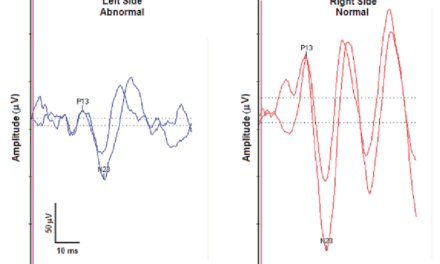The DizzyDoctor System, designed by Ian Purcell, is a a vertigo recording application paired with goggles to hold a smartphone in place, helping to enable patients to use their smartphones to record eye movements in “real time” during an attack of disequilibrium or vertigo.
The data, if collected properly, are said to help allow a physician to better identify why a patient has episodes of dizziness. Recordings from the application—including video, motion, and pupil tracking—can all be automatically uploaded to the DizzyDoctor website. For a fee, this data can be processed for the purpose of diagnosing. The physician then has the ability to access this data during the patient’s appointment, or even remotely if the patient is far from their nearest “DizzyDoctor.”
“Our goal is to make it easy for patients with dizziness to get tested accurately and quickly,” said Alex Bock, VP of Research and Development. “Most people go to Urgent Care when they get dizzy, but are often told to just rest. That doesn’t suffice. Dizziness is often a result of a physical block in the inner ear, and not providing the appropriate treatment can allow it to develop into a much larger problem.”
DizzyDoctor announced that it has selected Seamgen, a San Diego based digital product agency, as the software development partner for this project. Both the design and development of the application was completed by the Seamgen team.
Features include:
- Accurate eye movement and synchronized motion tracking video recording in the four proper Dix-Hallpike positions.
- Step-by-step voice instructions that walk the patient through the testing positions.
- 3D positional recognition from the phone’s internal sensors that require the patient to be in the exact testing position before it proceeds with the eye movement recording.
- Eye tracking algorithms that analyze eye movement videos.
- Uploading of video recordings directly to patient and physician web-based portal.
- Patient and physician web-based video player that presents the analyzed data in an understandable format for a physician and patient to review at a later date.
- Find DizzyDoctors in your local area. If there is not one nearby, a patient can reach out to the leading physicians in the “Dizzy” field to review their data.
“DizzyDoctor is not stopping at ‘Dizzy’ applications,” said Bock. “Since we have developed a very advanced eye tracking algorithm we will be building other mobile medical devices that can pull data from patient’s eye behavior. Eyes are the gateway to the mind and we can use that data for many different applications.”
The development of remote connected healthcare software technology has opened the healthcare industry to a world of opportunity. Mobile technology allows medical practitioners to provide remote diagnostics, access web-based medical records, offer timely patient information, and conduct post-procedure patient monitoring.
Additionally, the Internet of Things (IoT) creates many opportunities for medical device companies to offer cloud-based platforms to facilitate wireless transfer, storage, and display of clinical data. With IoT in healthcare apps and devices, medical personnel can retrieve real-time patient data and provide timely, accurate, and data-driven diagnoses and treatments.
Source: DizzyDoctor
Image: DizzyDoctor





